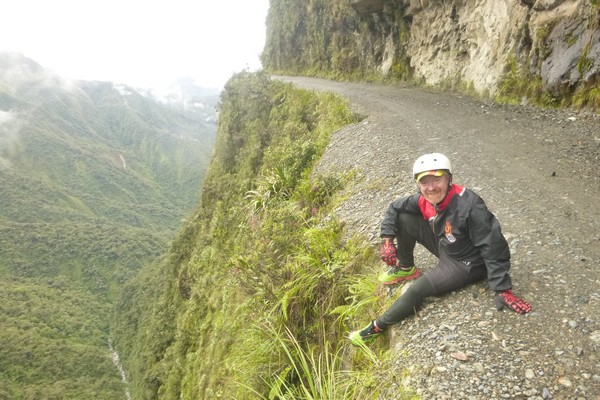 Time to tick two more bucket list items off my cycling list – to ride down the ‘world’s most dangerous road’ and to cycle through the mountains of Bolivia.
Time to tick two more bucket list items off my cycling list – to ride down the ‘world’s most dangerous road’ and to cycle through the mountains of Bolivia.
My first bucket list item was to cycle the ‘Death Road’. The road had been dubbed ‘El Camino de la Muerte’ as it claimed the lives of between 200 & 300 people a year before a new road was opened.
Today, it is still used by traffic but the main users now are mountain bikers who use the road to descend 60km from over 15,000ft at the summit to 3500ft at the village of Yolosa. It is one hell of a ride and you can reach speeds of over 50kmph as you descend down the unsurfaced road. Accidents do still happen and mountain bikers have lost their lives as they lose control and fall upto 400m straight down off the side of a cliff. In a way that is why hundreds of mountain bikers a year try their luck descending the ‘death road’.
I had booked the ride with a company called Gravity as they have an excellent reputation for safety and using the latest bikes (Kona Entourage with double suspension and hydraulic disk brakes no less). The pickup point was a café called Sol y Luna at 7.30 am and once everybody had arrived there were 13 of us in total. We jumped on the bus and headed for the summit, which lay at 15,400 ft, where we would start the ride.
It took us about an hour to drive to the summit and once there we got there we donned our safety gear
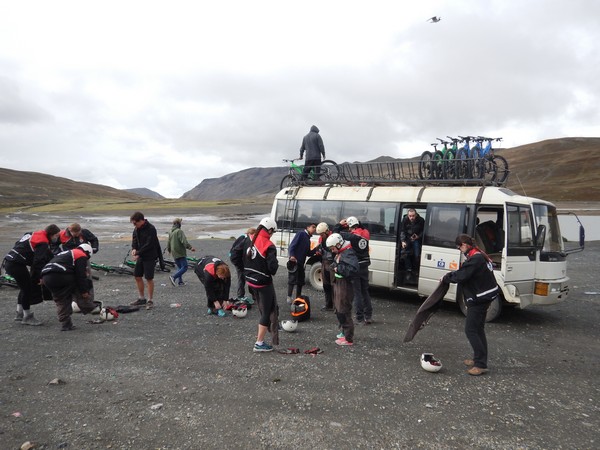
The staff got our bikes off the roof of the bus and we took them for a spin. Each of the bikes had a name and a symbol on the crossbar so that you always got back on the same bike after stopping – mine was called ‘The European Union’ which I thought was fairly apt given what was happening back home with Brexit.
The mechanics back at the work shop had set the brakes up according to your nationality i.e. for a British bike the front brake is normally on the right. As I had been living in Asia though I was used to the front brake being on the left and as the bikes had disc brakes they were fairly sharp and so not to be confused they quickly swapped my brakes over to what I was used to. Apparently the reason why the front brake is on the right is that when you are turning and crossing traffic you need to indicate with one arm and be holding the back brake with the other, so in the UK you need to indicate to turn across the traffic with your right arm and use the back brake with your left. In countries that drive on the right it is the opposite.
Once everybody was satisfied with their bikes and equipment it was time for a safety briefing on how to descend safely i.e. single file and if you need to overtake what to shout etc.
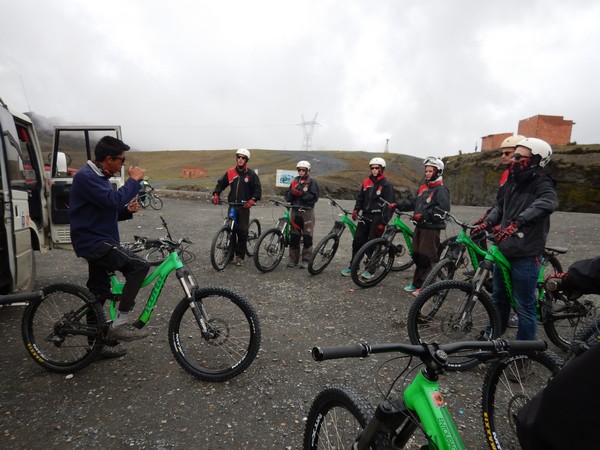
It was now time for the blessing for good luck from Pachamama, who is a goddess revered by the indigenous people of the Andes and known as the mother of the earth, which meant drinking a mouthful of Bolivian moonshine, aka Singani and pouring a bit over your bike tyre to keep us from flying over a precipice.
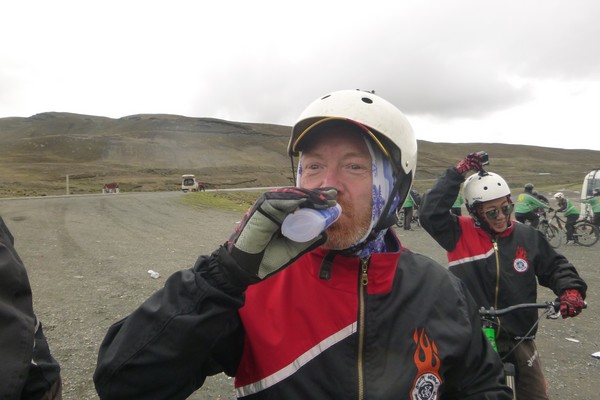
Now that the gods were on our side it was time for a ‘team’ photo which could well have been one of our last ones given the reputation that the road has.
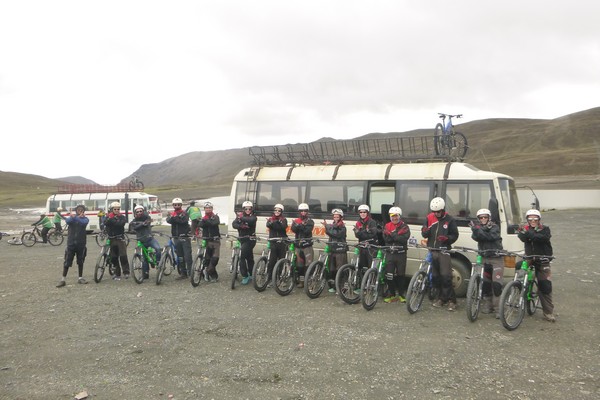
It was then time to head off and get on with the job of cycling downhill at +50kmph. The first part of the ride from the summit is on sealed roads and this was a fantastic way to get used to how the bikes handle and how sharp the brakes were etc.
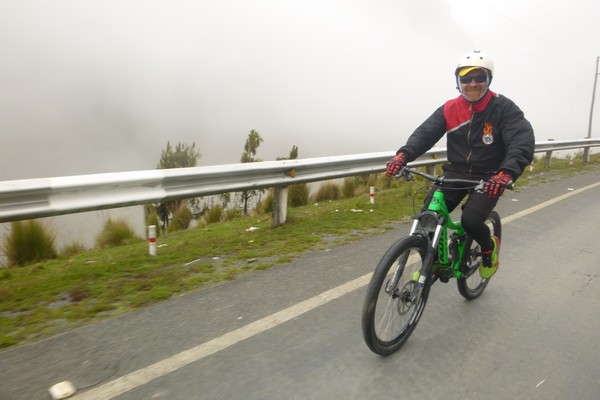
After a few kilometers we pulled over at a mirador just to check that everybody was happy with their bikes.
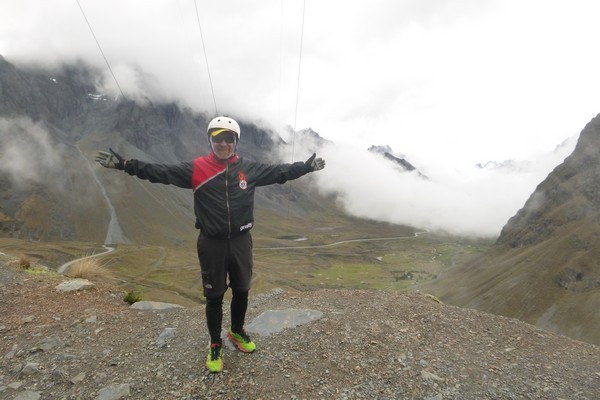
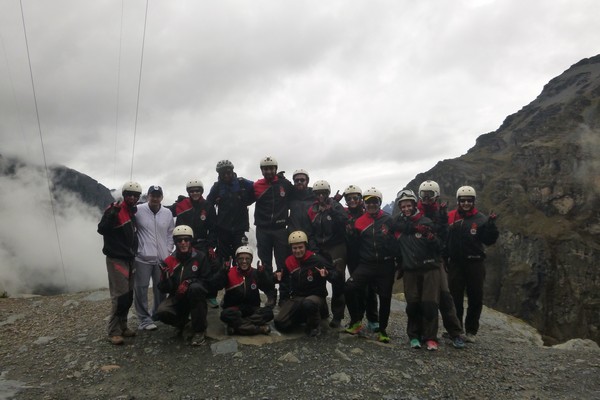
The guy in white was Roberto who was just along supporting his friend Chelsea as he had biked the road three times before.
As we descended we were heading straight through the clouds and at some points you had clear visibility while round the corner there was only a couple of metres at best.
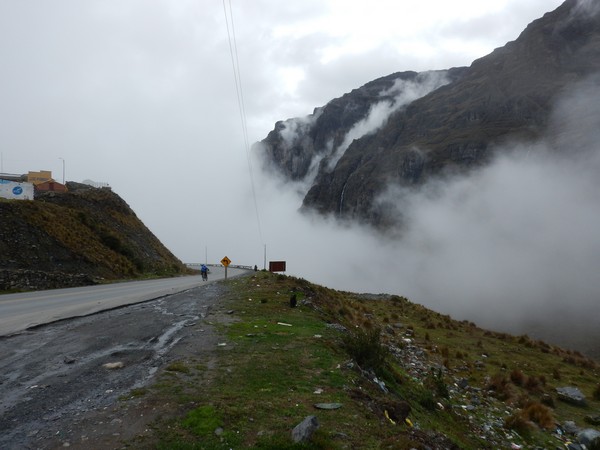
We were accompanied on the ride by two members of staff, Noel and Danny, and one of them rode at the front while the other stayed at the rear. Accompanying the bike convoy at the was the bus that we had caught up to the summit. Having the bus behind was good as it meant that as we descended and it got warmer we could peel off the extra layers.
The descent on tarmac was brilliant fun and as the name of the company, Gravity, suggests to gain speed it is about sticking your head and shoulders over the handlebars and when you were in the clouds this really was an adrenaline rush, especially when you hit a pot hole at 60 kmph. Thankfully the bikes had full suspension so hitting the holes was not really an issue even at that speed. Every 10 km or so we stopped to regroup which gave us a chance to warm our hands at the air at the top was bitterly cold.
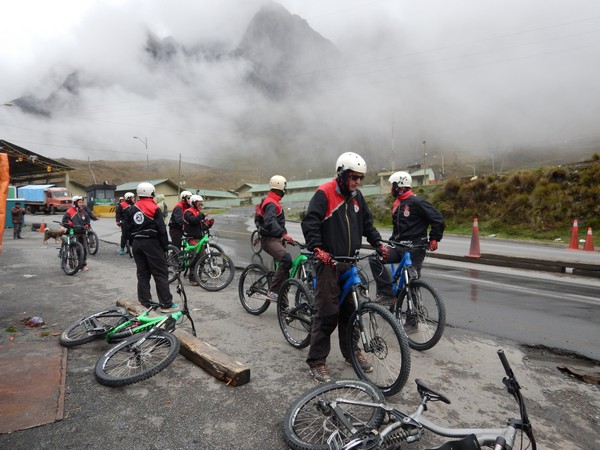
It was then time to hit the section that we had all come for – the off road section down the death road.
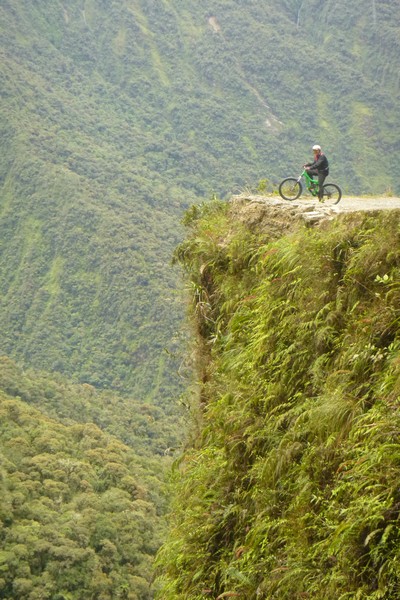
In the picture below you can see how remote the area is that we were cycling through and how steep the valley sides are.
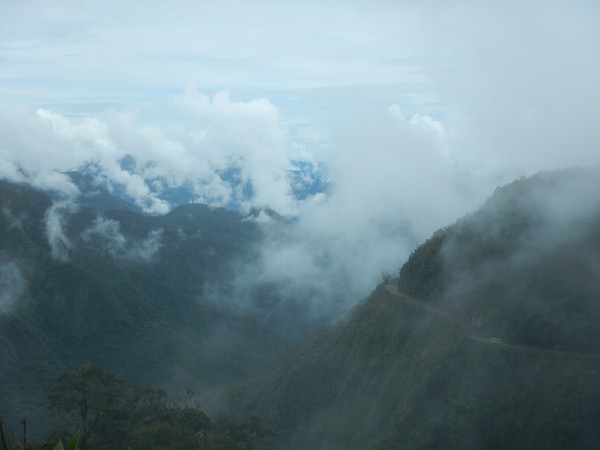
The road is cut into the hill sides and is a fantastic descent on a mountain bike but I wouldn’t like to try driving down the road and passing another vehicle coming up it.
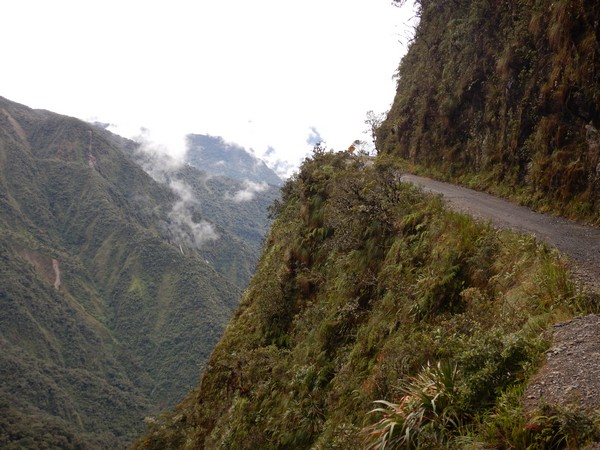
To add to the adrenaline rush there were waterfalls that cascaded down onto the road that we wee cycling down
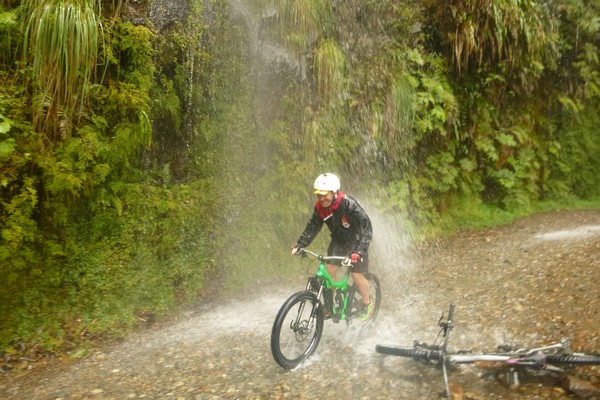
The drop-offs along the road really were huge and in excess of 400m in places. Noel said that they carried a rope but it was only 100m in length as if you went over a cliff where the drop was more than that then there would be no real rush to try and get to you as you would be dead.

The weather had been kind to us and it had not rained all day so I was dry which was great as I only had one set of clothes with me. However, just as we were at the bottom there was a river crossing where I got drenched
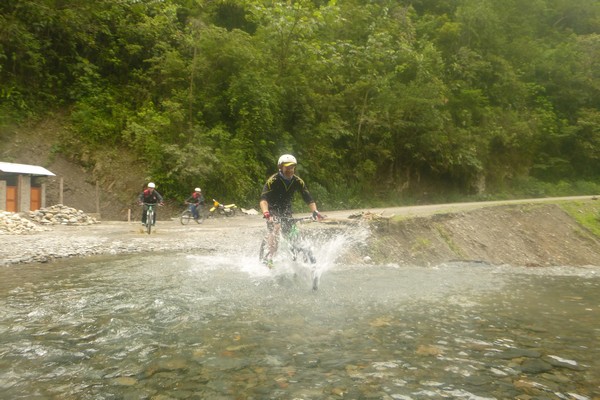
It really was an amazing descent and thankfully we all made it to the bottom alive
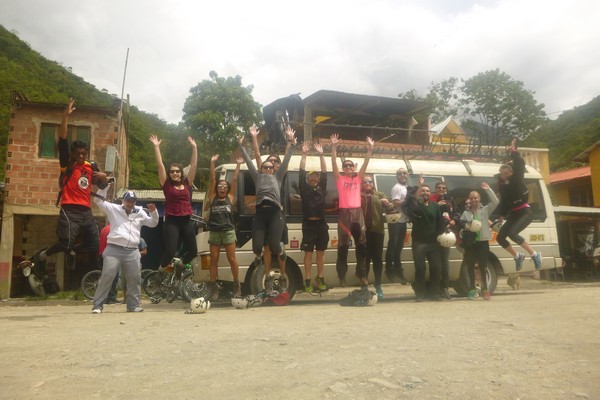
After a beer at the bottom we headed to an animal sanctuary to have a late lunch before all jumping back onto the coach for the trip back to La Paz. As it was a 3 hour journey back there was only one thing to do – buy a bottle of the local moonshine to make the journey go quicker.
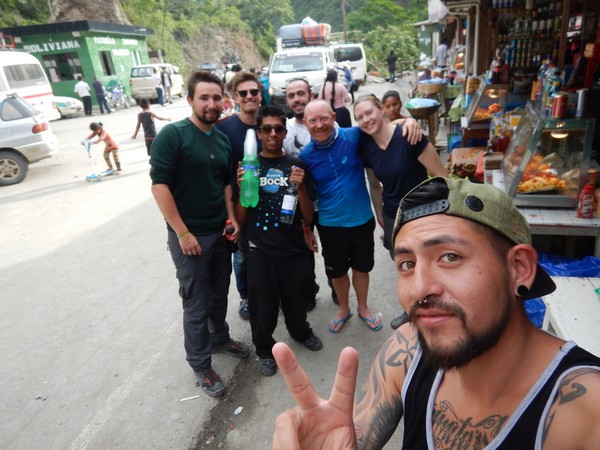
The local moonshine is the same stuff that we poured over our tyres at the beginning of the ride and it is made from corn. It comes in 3 different coloured bottles with the cheapest being a blue bottle. Guess which one we bought?
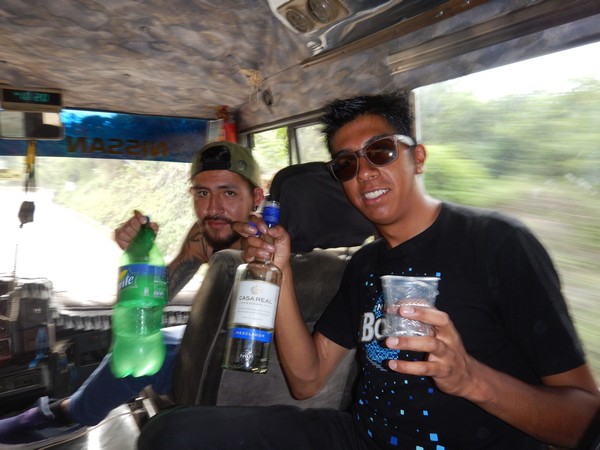
To take the edge of it Noel and Danny added lemonade and even though the first couple of glasses tasted bad the third one wasn’t too bad. I think that everybody else on the bus felt the same as after only 30 minutes we had to pull over to buy another couple of bottles.
The view from the bus as we climbed back up to La Paz was simply stunning:
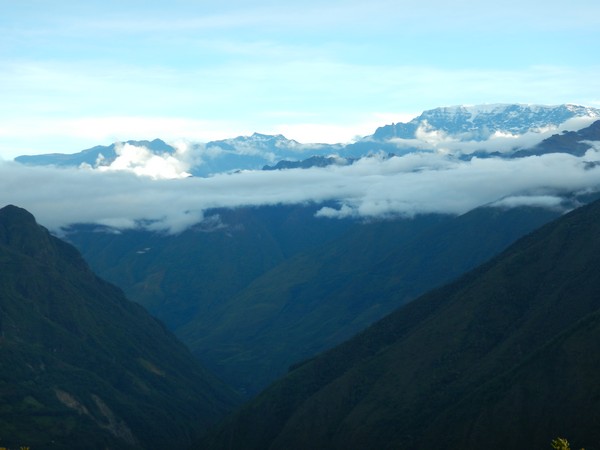
Back on the bus Danny became the DJ and he definitely has a very eclectic collection which included of all things – The Spice Girls. Everybody sang along though and the 3 hour bus journey flew by.
I think that you can safely say that the majority of the bus were slightly sozzled by the time that we got back to La Paz
The night before I had stayed in a hotel in the centre of the city but when we arrived back I was heading back to Roberto’s house on the outskirts of the city as I needed to collect my bike and start riding south. Chelsea and Roberto who had been on the bus were heading that way and so I jumped a taxi with them as far as La Florida where they dropped me off in the main plaza.
From there I caught another taxi back to the house in Isla Verde and when I got back Emil, Roberto’s son, had flown in that day from Cochabamba where he had spent Christmas and new year. The rest of the family were flying back at the weekend but as Emil attended an American curriculum school they followed the northern hemisphere school year and so he was back at school the next day.
I had planned to set off cycling the following morning but my phone is a 3G phone and in Bolivia as all of the technology is newly installed the frequencies are 4G and so when I was in Lake Titicaca my phone would not work whilst other people who had 4G phones and were with Entel had no issues. As I use my phone for routing then not having a working phone would have been a disaster as cycling though the Altiplano will mainly be on sand/dirt tracks and without GPS I can guarantee that I will soon get lost.
Now buying a phone is easier said than done in La Paz as most people seem to buy contract phones rather than just handsets and when I caught a minibus into La Florida the following morning it took me a good couple of hours of hiking around the town to find one that I wanted. I bought a very basic phone which cost me 100 USD but as it was 4G it would work in the middle of nowhere.
I met Roberto for lunch and then headed back to the house and spent the rest of the day downloading all of the apps and maps that I had previously installed on my other phone.
The last time that I had cycled was when I went to Alison’s house on the 13th of December and as it was now the 11th of January it meant that I had had nearly a whole month off the bike. I was ready for a couple of weeks break after cycling non-stop for nearly 6 months but taking a whole month off felt like a bit too long and I was really happy to be getting back on the bike.
Roberto had taken the morning off work to ride with me out of La Paz which was great and Emil wanted to come too instead of going to school.
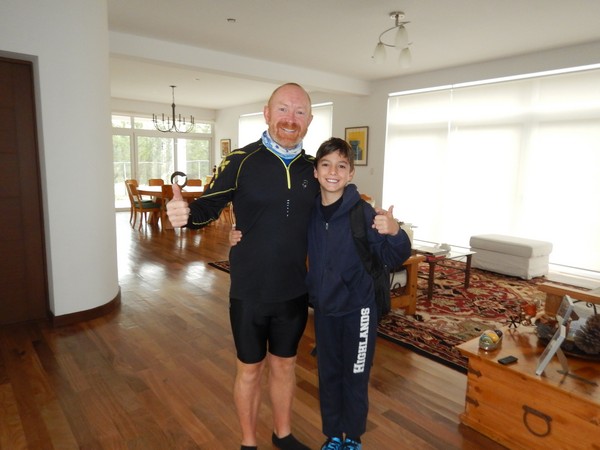
If you have read my previous posts then you will know that La Paz lies at the bottom of a river canyon and to get out of the city you need to climb nearly 700m straight up. Thankfully for me they had recently installed a cable car across the city and since November bicycles were allowed on it. I would use this to get out of the city and save myself the climb after nearly a month off the bike.
As we set off from Isla Verde the weather was not being kind and it was drizzling with rain
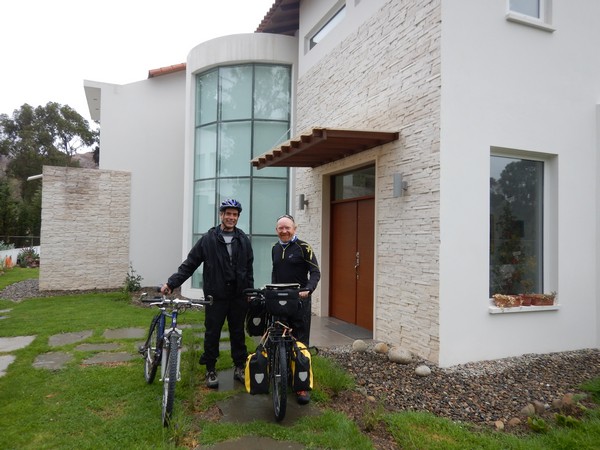
By the time we had descended into La Florida though the rain had stopped and the sun was even showing an appearance. We headed for the teleferico station to catch the cable car and Roberto made light work climbing the stairs to where you catch the cable car.
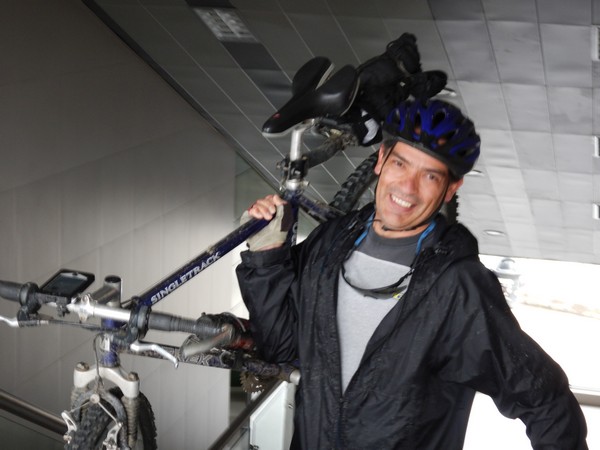
For my fully loaded bike it took three of us to carry it up the stairs.
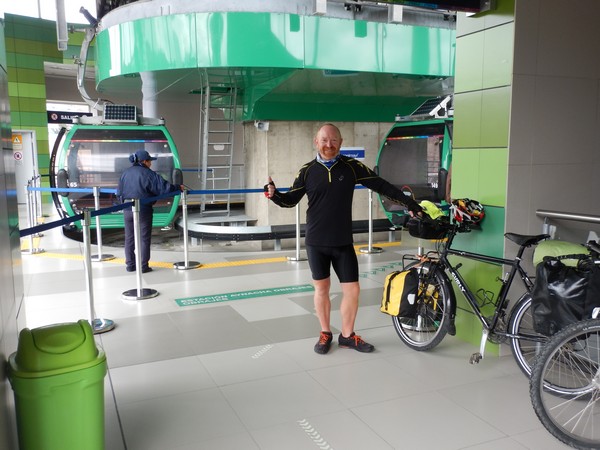
It was then all aboard as we flew over the city to El Alto where we would start cycling:
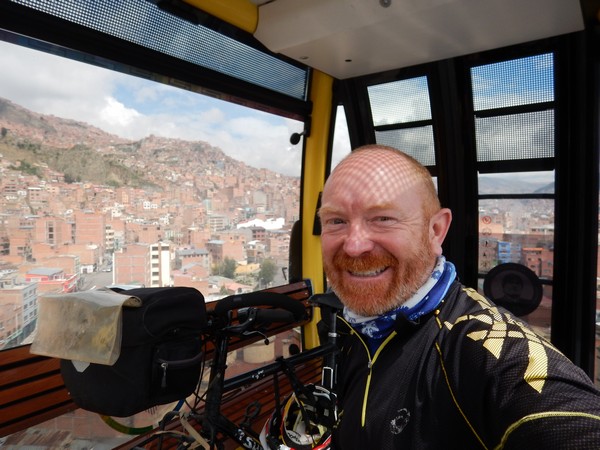
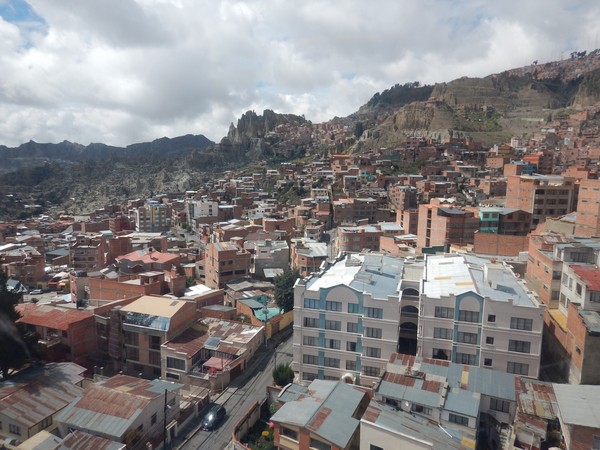
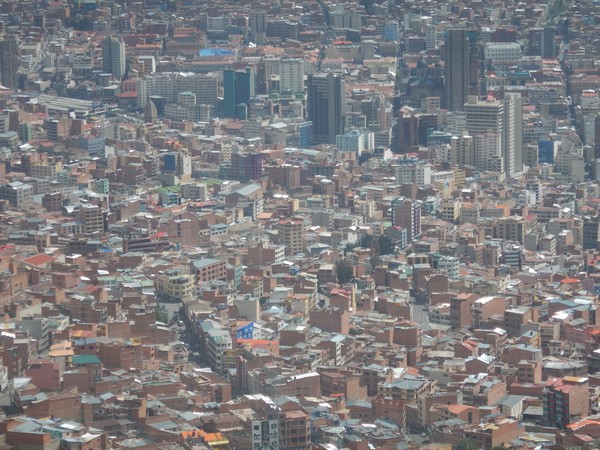 Having Roberto with me made light work of leaving the city as I didn’t have to even think about directions. He was originally going to join me for the first 5km before taking a turn off for the 9km descent back to his house but decided to join me for around the first 30km.
Having Roberto with me made light work of leaving the city as I didn’t have to even think about directions. He was originally going to join me for the first 5km before taking a turn off for the 9km descent back to his house but decided to join me for around the first 30km.
Once we were out of the city we were soon cycling through the Altiplano. The Altiplano is a plateau and on both sides you have mountains. Even though it is called a plateau there were still continual rolling hills to climb and I could really feel the affects of the altitude on not only my breathing but also in the muscles in my legs. Hopefully some of this was just from having a month off the bike and was not solely down to the altitude although we were cycling at 12,000 ft.
After an hour we reached a toll booth and this was where Roberto turned around to head back to La Paz. It had been a fantastic week that I had spent with Roberto as my guide and I can say that I now have a new friend for life and would just like to say thank you for showing me such a great time whilst I was in La Paz.
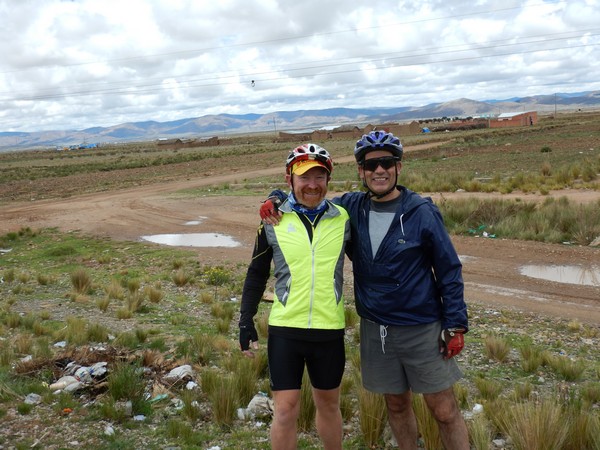
I was now on my own and it was time for me to get my head down and cycle south. Bolivia has a total population of only 10 million and once we were out of the city I really was cycling through a vast empty space.
The only problem with open spaces is that the wind tends to pick up and unluckily for me it was a head wind. As I was cycling through an area of agriculture I had a fair few tractors that I could use as a windbreak
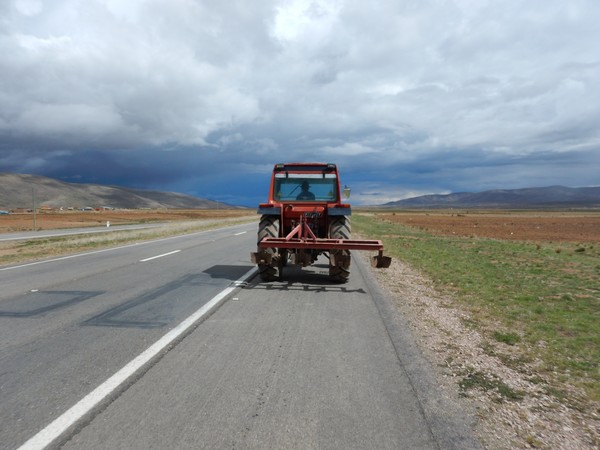
Here is a video that I shot on my way out of La Paz:
My destination that night was Patacamaya which lies 100km south of La Paz and even though it was a fair distance and I had not been on the bike for so long the kilometres rolled by as the scenery was stunning.
As I was approaching Patacamaya I saw my first cycle tourists in South America.
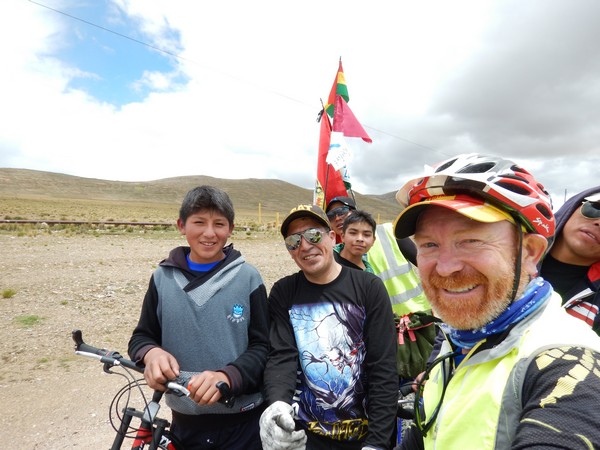
They were a group of lads from Oruro who were heading towards Lake Titicaca. They tried to explain why they were doing it but with my limited Spanish I couldn’t really understand what they were saying but it didn’t matter as we all shook hands and headed off on our separate directions.
Many of the buildings that I was passing along the road were made from mud bricks and had thatched roofs
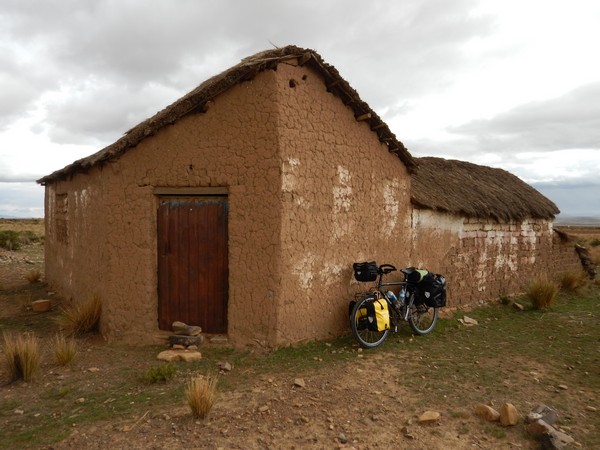
Bolivia is a very poor country and much of the population make their living from the land and live very simple existences. For me, I was already having a feeling that Bolivia was going to be one of the highlights of my round the world cycle and it was only day 1 of my ride through the country.
The first main village with any sign of life that I passed through was Tolar which is 67km south of La Paz. Here there a few restaurants and a couple of places to stay. Before here on the road there is literally nothing except the odd gas station and farming community off in the distance.
As this was the first place that I had passed I pulled in for lunch or ‘almuerzo’ and ordered the ‘menu del dia’ which is a set lunch that most places offer and consists of a soup and main course.
Once I was back I continued my cycle south towards Patacamaya and as the afternoon wore on the rain clouds started to gather as they had nearly every afternoon that I had been in Bolivia. Soon I could hear thunder and see lightening in the distance but thankfully I only caught the very edge of the rain storms and didn’t have to put on my wet weather gear.
Every 10km or so I was now passing through a village which had a shop and a place to stay if I needed to pull off the road.
At around 6pm I arrived at Patacamaya and as I cycled down the main street I could hear crowds shouting in the distance. I headed off to find out where the noise was coming from and discovered that there was a 3 day football tournament in the town.
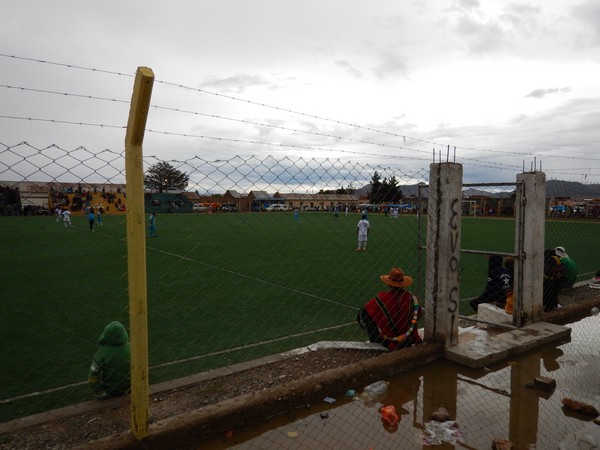
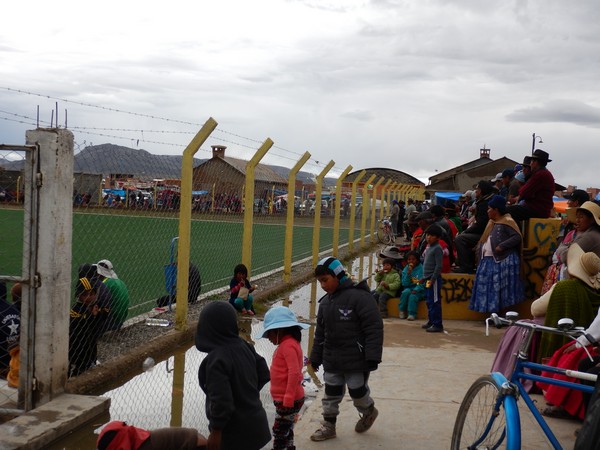
This match was well attended and crowd participation was very enthusiastic to say the least. Lots of people came over to say hello but although I have a rudimentary grasp of Spanish I soon get lost when people start having conversations where I don’t know the context of what they are saying. Still, a big smile goes a long way and people were happy to see me.
After watching the game for 20 minutes it was time to head into the town to find somewhere to sleep.
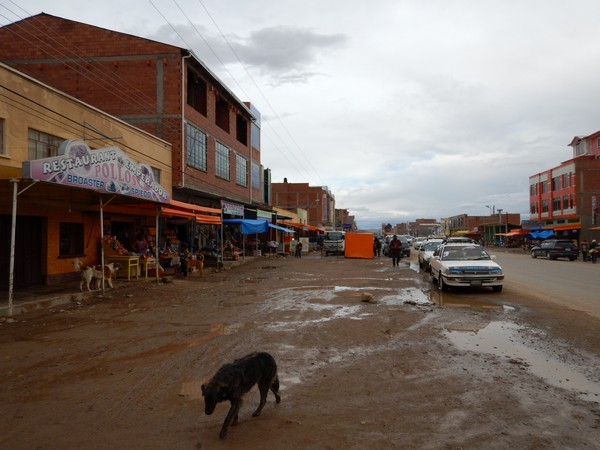
The sign that I was looking for on the outside of the buildings was Alojamiento which means accommodation. Luckily for me there was no shortage of signs and I must have passed 15 by the time I had cycled from one end of the town to the other. 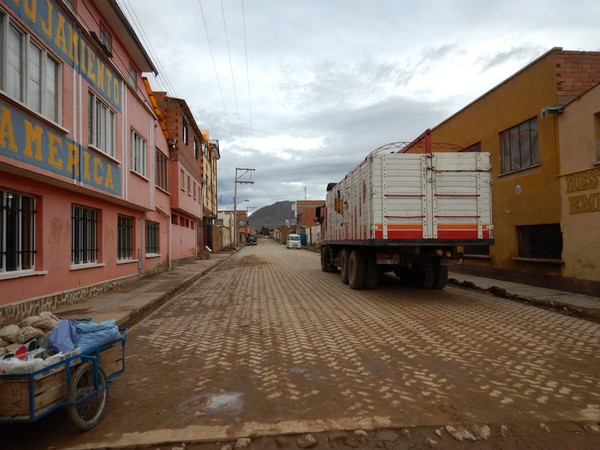 As I had no idea what any of them were like I just picked one at random and headed up the stairs to find the owner.
As I had no idea what any of them were like I just picked one at random and headed up the stairs to find the owner.
When I found her she said that it was 30 BOL for a room with a shared bathroom and 40 BOL for one with a private bathroom (current exchange rate is 10 BOL to 1 GBP). As it was only 10 BOL more for a private bathroom I chose the slightly more expensive one. Still at 4 GBP my money would go along way in Bolivia.
I like to see a room before I pay for it and the owner found this to be a strange request but when it became clear that I wasn’t going to just hand over the money she took me down to see the room.
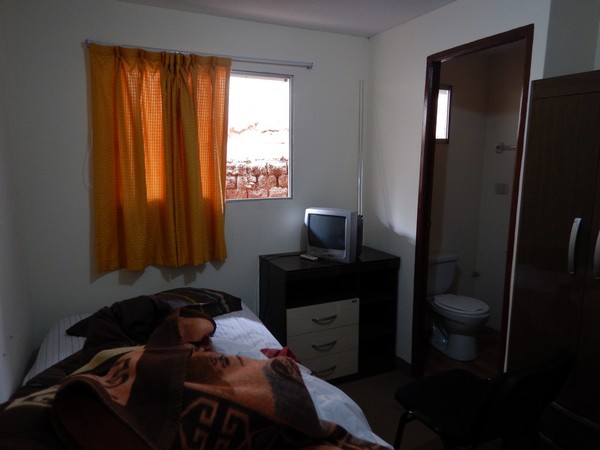
It turned out to be a nice room and the only concern was the walls which were made out of plywood. Hopefully I would not get loud neighbours move in next door. The other thing that seemed a little odd was that I was only allowed one shower during my stay and I had to decide if I wanted it now or in the morning. As I had been cycling all day I said that I wanted it now and once I had paid her she went off to turn the gas on. She said that she would turn it off again in 15 minutes and walked off back to her room upstairs.
After a hot shower it was time to head into town to find something to eat. I found a restaurant a couple of doors down which did ‘Cena’. Like at lunchtime it is a set menu of soup followed by a main course which normally consists of rice and meat. For 10 Bol you can’t complain and the food was very tasty.
That day I had cycled 100km and given the altitude I was feeling very tired after my first day back on the bike. By 8pm I was tucked up in bed and even though the walls were made from plywood I had a fantastic nights sleep and never heard a thing.
My plan for my time cycling through Bolivia was to spend two days cycling down sealed roads towards Sajama National Park The park is home to snowcapped volcanoes and wildlife which includes Llamas, Alpacas, Armadillos, Bears, Pumas, and pink flamingos.
I will probably spend 3 days cycling through the National Park and then once I leave I will be on totally off road tracks of sand and dirt as I head south through the Andes Mountains towards the salars (salt flats) and then continue south towards either Argentina or Chile. It is going to be a fantastic few weeks of getting away from civilisation and hopefully I won’t get too lost along the way.
Hi Stewart, This is Cuan. I think the Death Road looks likes Conor Pass. I miss you
Hi Cuan,
I thought so too.
See you in a few months.
xxxx